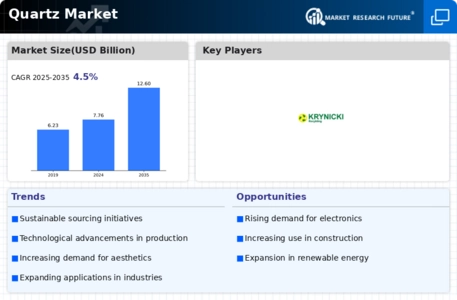Market Analysis
In-depth Analysis of Quartz Market Industry Landscape
The quartz market is a dynamic and rapidly evolving sector influenced by a variety of factors that shape both supply and demand within the industry. Quartz, a mineral composed of silicon dioxide, is widely used in various applications due to its unique properties such as high hardness, chemical inertness, and electrical conductivity. The dynamics of this market are driven by factors such as technological advancements, industry trends, regulatory requirements, and economic conditions.
Technological advancements play a crucial role in shaping the quartz market dynamics. Continuous innovation in extraction, processing, and manufacturing techniques has led to the development of high-quality quartz products with enhanced performance characteristics. These advancements enable manufacturers to produce quartz materials that meet the stringent requirements of diverse applications, including semiconductor manufacturing, electronics, optics, and construction. For example, advancements in crystal growth technologies have enabled the production of large, high-purity quartz crystals used in semiconductor wafer fabrication, while improvements in engineered quartz surfaces have expanded their use in countertops, flooring, and other architectural applications.
Industry trends also influence the dynamics of the quartz market. Factors such as urbanization, infrastructure development, and the expansion of the electronics industry drive demand for quartz materials. The increasing adoption of quartz-based products in residential and commercial construction projects, such as kitchen countertops, bathroom vanities, and wall cladding, reflects the growing preference for durable, low-maintenance materials with aesthetic appeal. Moreover, the proliferation of electronic devices, including smartphones, tablets, and wearable devices, creates opportunities for the use of quartz components such as quartz oscillators, resonators, and filters in electronic circuits.
Regulatory requirements and standards also play a significant role in shaping the quartz market dynamics. Quartz products used in critical applications such as semiconductor manufacturing and medical devices must comply with industry-specific regulations and standards related to purity, cleanliness, and performance. For example, quartz crucibles used in semiconductor wafer fabrication must meet stringent cleanliness requirements to prevent contamination and ensure the reliability of semiconductor devices. Additionally, regulatory requirements related to environmental protection, worker safety, and product quality influence manufacturing processes and supply chain dynamics within the quartz industry.
Economic conditions and market trends impact both supply and demand dynamics in the quartz market. Factors such as industrial output, consumer spending, and technological innovation affect the demand for quartz materials in various end-use sectors. Economic downturns may lead to reduced construction activity and lower demand for quartz-based building materials, while periods of economic growth and recovery stimulate demand for quartz components in electronics and other high-tech industries. Moreover, fluctuations in raw material prices, energy costs, and currency exchange rates can impact the cost of production and supply chain dynamics within the quartz industry.


 Source: Secondary Research, Primary Research, Market Research Future Database and Analyst Review
Source: Secondary Research, Primary Research, Market Research Future Database and Analyst Review

Leave a Comment